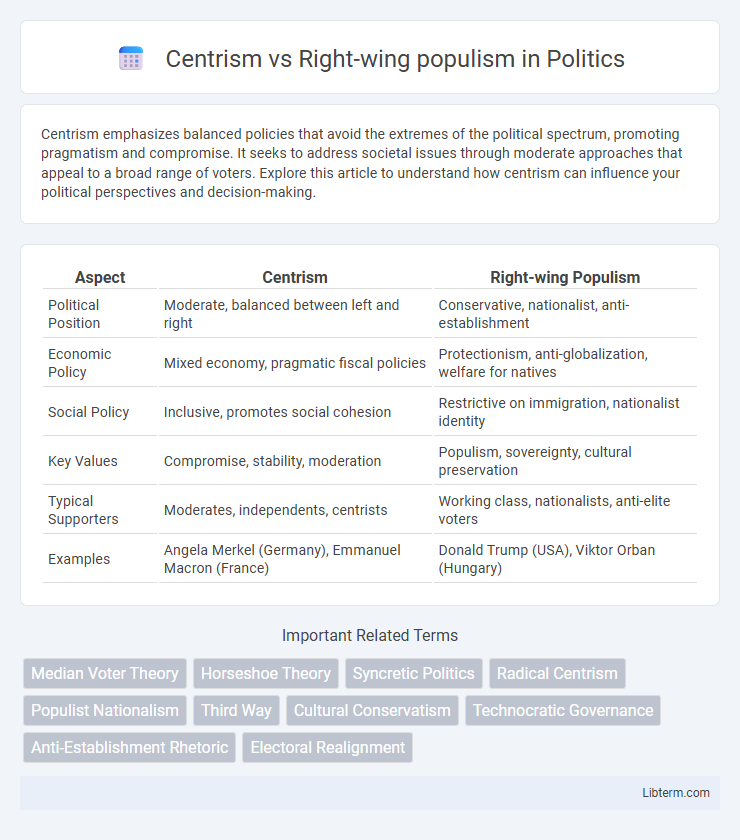Centrism emphasizes balanced policies that avoid the extremes of the political spectrum, promoting pragmatism and compromise. It seeks to address societal issues through moderate approaches that appeal to a broad range of voters. Explore this article to understand how centrism can influence your political perspectives and decision-making.
Table of Comparison
| Aspect | Centrism | Right-wing Populism |
|---|---|---|
| Political Position | Moderate, balanced between left and right | Conservative, nationalist, anti-establishment |
| Economic Policy | Mixed economy, pragmatic fiscal policies | Protectionism, anti-globalization, welfare for natives |
| Social Policy | Inclusive, promotes social cohesion | Restrictive on immigration, nationalist identity |
| Key Values | Compromise, stability, moderation | Populism, sovereignty, cultural preservation |
| Typical Supporters | Moderates, independents, centrists | Working class, nationalists, anti-elite voters |
| Examples | Angela Merkel (Germany), Emmanuel Macron (France) | Donald Trump (USA), Viktor Orban (Hungary) |
Introduction: Defining Centrism and Right-wing Populism
Centrism advocates for balanced political views that often blend liberal and conservative policies, emphasizing pragmatic problem-solving and moderation. Right-wing populism centers on nationalism, anti-elitism, and strong stances against immigration and globalization, frequently appealing to the working class frustrated by political establishments. Understanding these foundational differences highlights the political spectrum's divide between inclusive governance and identity-focused, often exclusionary rhetoric.
Historical Development of Centrism and Right-wing Populism
Centrism emerged in the 19th century as a political position advocating moderate policies that balance progressive and conservative views, often promoting social liberalism and pragmatic governance. Right-wing populism gained momentum in the late 20th century, characterized by nationalist rhetoric, anti-immigration policies, and skepticism towards globalization, drawing support from disenfranchised economic groups. Both ideologies evolved in response to societal changes, with centrism adapting through coalition-building and right-wing populism capitalizing on cultural and economic anxieties.
Core Values and Ideological Foundations
Centrism emphasizes balance, pragmatic governance, and social cohesion, prioritizing moderate policies that often incorporate elements from both left and right ideologies to promote stability and inclusivity. Right-wing populism centers on nationalism, anti-elitism, and cultural identity, advocating for stricter immigration controls, sovereignty, and policies addressing perceived threats to traditional values. The core values of centrism revolve around compromise and gradual reform, while right-wing populism is ideologically grounded in protecting in-group interests and challenging established political institutions.
Political Strategies and Rhetoric
Centrism employs moderate political strategies emphasizing compromise, pragmatic policy solutions, and inclusive rhetoric to appeal to a broad electorate, often stressing unity and stability. Right-wing populism uses aggressive strategies targeting specific socio-economic grievances, employing nationalist and anti-establishment rhetoric to mobilize support through fear of immigration, economic insecurity, and distrust of elites. The contrast lies in centrism's appeal to consensus and continuity versus right-wing populism's emphasis on division and radical change.
Economic Policies: Centrism vs Right-wing Populism
Centrism advocates for balanced economic policies that blend market efficiency with social welfare, emphasizing fiscal responsibility and moderate regulation to promote stable growth and social equity. Right-wing populism favors protectionist measures, deregulation, and tax cuts aimed at stimulating national industries and appealing to working-class voters, often prioritizing short-term economic gains over global trade commitments. These contrasting approaches impact labor markets, trade policies, and social spending, reflecting divergent visions of economic nationalism versus pragmatic compromise.
Social Issues and Cultural Attitudes
Centrism in social issues emphasizes balance, advocating for moderate policies that combine progressive values with traditional principles, promoting inclusivity and gradual reform. Right-wing populism often champions nationalist cultural attitudes, prioritizing immigration control, traditional family values, and skepticism towards multiculturalism as a defense against perceived social and cultural erosion. The divide centers on varying approaches to diversity, identity politics, and the role of government in regulating social norms and cultural expression.
Public Perception and Electoral Support
Public perception of centrism often highlights its appeal to moderate voters seeking balanced policies, while right-wing populism attracts supporters through nationalist rhetoric and promises to address economic and cultural grievances. Electoral support for centrism tends to fluctuate in politically stable environments, appealing to the political center, whereas right-wing populism gains momentum during periods of social unrest and economic uncertainty. Voting patterns show that right-wing populist parties often mobilize disenfranchised demographics, unlike centrist parties which rely on broader but less passionate bases.
Impact on Democracy and Governance
Centrism promotes democratic stability by encouraging moderate policies and bipartisan cooperation, which helps prevent political polarization and institutional gridlock. Right-wing populism often challenges established democratic norms through nationalist rhetoric, anti-elitism, and undermining independent institutions, leading to weakened checks and balances in governance. The contrasting approaches significantly influence democratic resilience, with centrism fostering consensus-building and right-wing populism risking democratic erosion.
Global Trends and Influences
Centrism emphasizes balanced governance and pragmatic policies, often appealing to moderate voters across global democracies. In contrast, right-wing populism leverages nationalism, anti-immigration rhetoric, and skepticism towards global institutions, gaining momentum during periods of economic uncertainty and cultural anxiety worldwide. The clash between these ideologies shapes electoral outcomes and policy directions in regions including Europe, the Americas, and parts of Asia.
Future Prospects and Challenges
Future prospects for centrism include the potential to unify diverse voter bases by advocating moderate policies that balance economic growth with social equity, adapting to shifting demographics and global uncertainties. Right-wing populism faces challenges in sustaining momentum amid increasing scrutiny over nationalist rhetoric and policy sustainability, yet it may continue to appeal by addressing economic disenfranchisement and immigration concerns. Both political approaches must navigate evolving digital information landscapes and rising political polarization to effectively influence future governance.
Centrism Infographic

 libterm.com
libterm.com